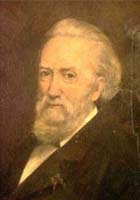Theodor Storm Biography
Theodor Woldsens Storm, well known poet and writer, was born September 14th, 1817 in Husum, Germany. He became a lawyer in 1842, but he was exiled (1853-64) by Denmark for pro-Prussian sentiments. It was only in 1864 that he was able to return to Husum, where in 1874 he became a judge of the Court of Appeals.
As early as 1843 he had made himself known as a lyrical poet of the
Romantic School, but it was as a short-story writer that he first took
a prominent place in literature with the story entitled Immensee in 1849.
The work, which Storm himself referred to as a "Perle deutscher Poesie" (pearl of German poetry) reached over thirty editions and was translated into 17 languages by the time of the author's death. But in addition to being called a masterpiece by such leading literary lights of the day as Theodor Fontane and Paul Heyse, Immensee also attracted its share of criticism as a mere sentimental love story. Then in the 1930s and forties Storm's novella was seized upon by right-wing critics as appropriate National Socialist reading material, which had the effect of sullying its reputation somewhat long after 1945. Since the 1960s Immensee's critical reputation has been rehabilitated and both novella and Storm himself analyzed from a variety of viewpoints, including Marxism and democratic humanitarianism.
Storm's literary work was based on personal experience rather than political attitudes. His contacts in Berlin with the literary club 'Der Tunnel Uber der Spree', and notably with Theodor Fontane, sharpened his northern individualism, though they stimulated his development as a writer. His strong personality was nurtured by his profoundly emotional sensibility and an increasing scepticism, which inclined him to determinism.
Theodor Storm's life-long interest in writing fairy tales found its most consummate expression in 1863 with the writing of The Rainmaiden ("Die Regentrude"). The story of a young girl who enters a subterranean realm in order to awaken the sleeping rainmaiden and to revive a drought stricken countryside is a metaphor for Storm's own descent into the realm of his subconscious in order to activate his slumbering creative powers.
The last and greatest of his works was The Rider on the White Horse. In this masterpiece, Storm exhibits a man's will in conflict. On one side, with unintelligent conservatism among his fellowmen and, on the other, with the forces of nature. The figure of the dike-master emerges from the double struggle with a fine impressiveness; and the tragedy which finally engulfs him and his family is profoundly moving. At the same time we are given a vivid picture of the landscape of the low-lying coast of the North Sea, with the ever-present menace of the flood tide; and the sternness of the action is tempered with glimpses of humor and a picture of warm affection. Here Storm's art reached a pitch which places him beside the masters of the short novel.
Storm died of cancer July 4, 1888 in Hademarschen.
Clouds gather, treetops toss and sway;
But pour us wine, an old one!
That we may turn this dreary day
To golden; yes, to golden!
...
Close both my eyes
with your beloved hands!
For everything I suffer
comes to rest under your hand.
...
